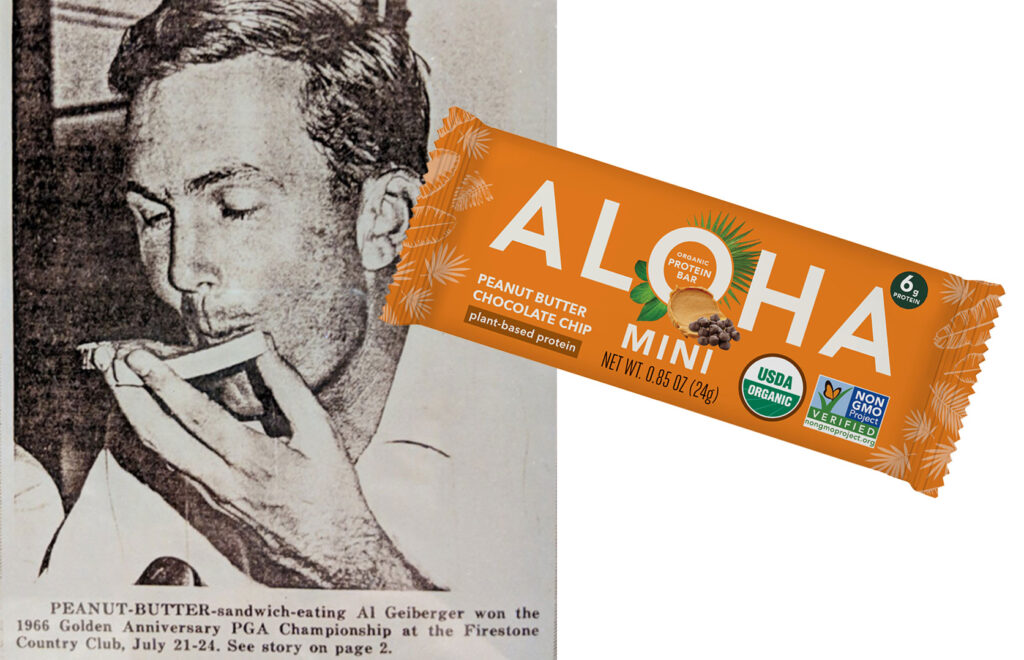On-course nutrition options have come a long way since the PB&J!
By Neil E. Wolkodoff, PhD
In over 25 years of working with golfers of all levels, from the recreational to major winners, I have seen almost every concept in golf nutrition.
It all started with Al Geiberger, “Mr. 59,” eating a P&B sandwich on the way to victory in 1966. That average 350 calories in that sometimes-gooey treat are about the same as many meal replacement bars. Except for the potential golf glove re-coloring, not a bad choice on the course.
Keeping up your energy and focusing on the course for your best performance revolves around some basic principles. Going from very little golf in the off-season to two-plus weekly rounds will result in some changes in weight due to increased energy output. Golf is not the time to embark on the keto-weight-loss challenge and go into full starvation mode.
Golf is the constant expenditure of calories because of the time involved, not the rate. Conversely, golf is a relatively small energy drain compared to other activities like alpine or cross-country skiing. Something to give you just enough fuel is the best perspective on food choices.
One premise of this short article is you have experimented with on-course hydration and have a routine.
Digestion is not instant, no matter what you consume. If you are playing at 2 p.m., your breakfast is really becoming usable at that point. The simpler the food, the faster the usability. For example, if you used an energy gel for the last 9 holes, it would be available in the system after 20-plus minutes. If you consumed some nuts and dried fruit at the turn, that will probably only be partially usable once you sit at the 19th hole. This is one of the reasons specific strategies work and others don’t. It is about time for usability, and there are individual differences.
Skipping a meal puts you behind what you need for even energy and focus. Breakfast or lunch sandwiches, if they fit your taste and are close to your nutritional preferences, are easy to consume on the way. If it is a choice between fast food and nothing, the speedy option at least keeps you fueled.
Compared to even 10 years ago, products have much better ingredients from a health perspective. Whether you want cleaner, vegetarian, or vegan, your options have multiplied.
Meal Replacement (MP) bars contain a blend of protein, carbohydrates, fat, vitamins, minerals, and fiber, like a small, nutritionally dense meal squished into a bar. Full-sized MP products will range from 260-380 kcal per bar. One that has an excellent nutritional profile is Aloha Bars. The best strategy is one in the vehicle and one in the golf bag.
If you had something before the round, a little at the six and the 12-hole mark is one common strategy. The critical point here is that it is easy to consume, smaller rather than more significant, sits well with your digestive system, like the taste, and doesn’t make your hands a mess. Very important to keep the club from flying longer than the ball. These mini versions range from 100-160 kcal per bar on average.
Another hypothesis is don’t use the golf course to try new beverages or food products. You don’t know how they will react to your system, focus, and energy. Err on the side of known. If you have used some bar for a meal replacement in other situations, and it sits well with your system, you can use that on the course. I have had tour players try bars in practice rounds to see how they fare. It’s just like playing with the same brand and model of a golf ball. Find what works for you and stick with it.
If you really need a kick for the second nine, you can consider an energy shot with some form of caffeine. These products will hit the system in 20 minutes, with the peak effect starting at 45 minutes. Another product you should experiment with during practice is to see if the increased energy and focus impair the swing and coordination. Products like Ethan’s Energy Shots will provide a little lift without the jitters while putting.
Think 90/10 about golf nutrition. The most crucial nutritional consideration is what you do outside golf 90% of the time. You can then find things to match what works and what your taste buds prefer. And, if you can’t consume your preferred food or snack, a Snickers will not kill you.
Neil E. Wolkodoff, PhD, performs research on golf and sports, and provides programs to improve human performance and health. He has worked successfully with PGA, collegiate and junior golfers over the last 25 years. Neil is the Medical Program Director for the Colorado Center for Health & Sports Science.

